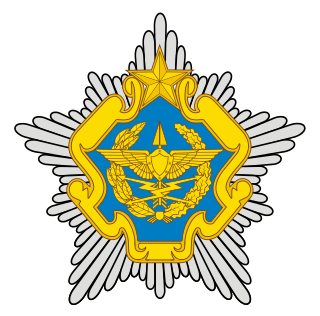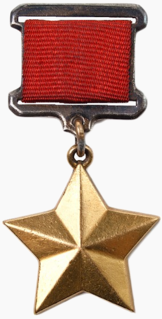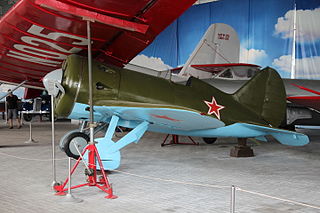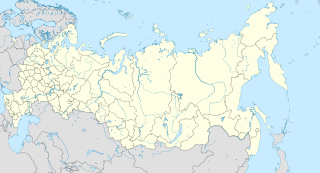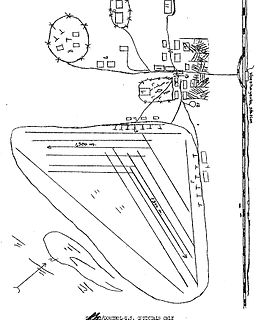
Vozzhayevka is an air base in Amur Oblast, Russia located about 100 km southeast of Blagoveshchensk. It is a medium-sized air base located near an SS-11 missile field at Svobodnyy. During the 1980s it was one of 17 airfields hosting the Soviet Union's tactical reconnaissance aircraft regiments.
The 1st Guards Stalingrad Bomber Aviation Division was an Aviation Division of the Soviet Air Force. It was formed as the 226th Assault Aviation Division in May 1942 and became the 1st Guards Stalingrad Assault Aviation Division for its performance in the Battle of Stalingrad. The division fought in the Melitopol Offensive, Crimean Offensive, East Prussian Offensive and the Battle of Königsberg. By the end of the war, the division had been awarded the Order of the Red Banner twice, the Order of Lenin and the Orders of Kutuzov and Suvorov 2nd class. Postwar, the division relocated to Belarus. In April 1956, it became a bomber division but was converted to a fighter-bomber unit in 1957. In 1989, it became an bomber unit again and moved to Krasnodar in 1993. At Krasnodar it became an assault unit. The division moved to Yeysk in 2002 and disbanded in 2009.

Baranovichi is an air base of the Air Force of Belarus and formerly of the Soviet Air Force. It appears to have the ICAO airport code UMMA.
The 486th Fighter Aviation Regiment was a fighter regiment (IAP) of the Soviet Air Force. It was formed in 1938 as the 12th Fighter Aviation Regiment and disbanded in 1960. The regiment was awarded the Order of Suvorov 3rd class and the Order of Bogdan Khmelnitsky. It fought in the Soviet invasion of Poland, Crimean Campaign, Battle of Kursk, Operation Bagration and the Vienna Offensive. Regimental personnel included flying aces and Heroes of the Soviet Union Pavel Terentyevich Korobkov, Dmitry Alexandrovich Medvedev, Nikolay Mikhailovich Gusarov and Andrei Girich. Throughout its career, the regiment operated the Polikarpov I-15, Lavochkin-Gorbunov-Gudkov LaGG-3, Lavochkin La-7, Mikoyan-Gurevich MiG-15 and Mikoyan-Gurevich MiG-17, among other aircraft.
The 372nd Fighter-Bomber Aviation Regiment was a fighter-bomber regiment of the Soviet Air Forces and the Soviet Air Defence Forces (PVO). It existed from 1951 to 1993 and was based in Daugavpils until 1993, when it was transferred to Borisoglebsk and disbanded.
The 256th Fighter Aviation Regiment was a fighter aviation regiment of the Soviet Air Forces. It existed between 1950 and 1959 and fought in the Korean War.
The 940th Fighter-Bomber Aviation Regiment was an aviation regiment of the Soviet Air Force. It was formed in 1942 in the Soviet Far East and fought in the Soviet invasion of Manchuria. During the last months of the Korean War, the regiment was relocated to China, but did not fight in combat due to the end of the war. After the end of the latter it was transferred to Belarus, where it served for the remainder of the Cold War, being converted into a fighter-bomber regiment in 1960.
The 105th Guards Borisov-Pomeranian Twice Red Banner Order of Suvorov Mixed Aviation Division is an aviation division of the Russian Air Force, based in Voronezh's Voronezh Malshevo air base.
The 180th Guards Fighter Aviation Regiment was a military unit of the Red Army Air Force, which took part in the fighting of the Great Patriotic War, and then became part of the Russian Air Defence Forces and finally the Russian Air Force.
The 86th Guards Fighter Aviation Regiment was an aviation regiment of the Soviet Air Forces, and after the dissolution of the Soviet Union, the main formation of the Moldovan Air Force.
The 726th Fighter Aviation Regiment was an aviation regiment of the Soviet Air Forces and the Soviet Air Defense Forces.
The 240th Fighter Aviation Division was a fighter aircraft formation of the Soviet Air Forces during World War II. It saw its most eventful actions during that war, and in 1949 became the 119th Fighter Aviation Division.
The 177th Fighter Aviation Regiment PVO was a fighter regiment of the Soviet Air Defense Forces during World War II and the Cold War, later becoming part of the Russian Air Defense Forces and finally the Russian Air Force.
The 176th Fighter Aviation Regiment PVO was a fighter regiment of the Soviet Air Defense Forces during World War II and the Cold War. The unit was disbanded in March 1960.

Blagodatnoye is an abandoned Soviet airbase in Khabarovsk Krai, Russia located 23 km east of Khabarovsk near the town of Kalinka. It was part of the Soviet Air Defence Forces Far Eastern Military District and hosted an interceptor regiment flying Sukhoi Su-9 (Fishpot) and MiG-17 (Fresco) aircraft. It was closed as a military base in 2009.

Galenki is a Russian Air Force base in Primorsky Krai, Russia. From January 5, 1942 to October 1945, the 582nd IAP was based at the aerodrome, taking part in the Soviet-Japanese war with Lavochkin La-5 aircraft.
The 761st Fighter Aviation Regiment was a fighter regiment (IAP) of the Soviet Air Force during World War II that became part of the Soviet Air Defense Force (PVO) during the Cold War as the 761st Fighter Aviation Regiment PVO. Converted to the 761st Training Aviation Regiment in 1965, it became part of the Russian Air Force after the Dissolution of the Soviet Union and was disbanded in 2009 as a result of military reforms, but reformed by 2017.
The 162nd Fighter Aviation Regiment was a fighter regiment (IAP) of the Soviet Air Force during World War II that became part of the Soviet Air Defense Force (PVO) during the Cold War as the 162nd Fighter Aviation Regiment PVO. It was disbanded in 1959 during the reorganization of the PVO.
The 100th Guards Fighter Aviation Regiment as a fighter regiment (IAP) of the Soviet Air Force during World War II and the early years of the Cold War.

